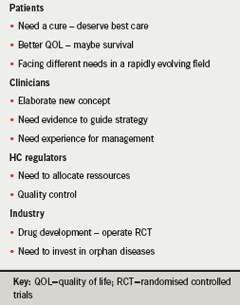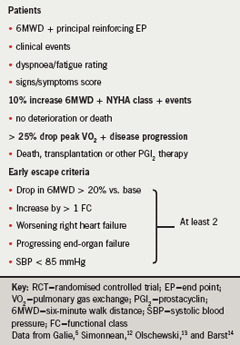Professor Jean-Luc Vachiéry, Université Libre de Bruxelles, Belgium, began by looking at progress in the management of PAH over the last 50 years. Current therapies are now based on experience with earlier treatments, including calcium channel blockers1 and surgery,2 and by more recent, evidence-based RCTs with newer drugs (figure 1).3-5
We are facing different needs in a rapidly evolving field, according to Professor Vachiéry. He outlined the many emerging issues in PAH (table 1), which is an incurable disease.6 Unequivocally, patients need a cure and better quality of life with enhanced survival, while clinicians need evidence to guide treatment strategies. This must be balanced by healthcare regulators, who will be under pressure to control the costs, and also by industry, which has a huge responsibility in this field, especially as PAH is considered to be an orphan disease.7

A likely first step might be to understand new targets. Evidence to guide clinical decision-making in how to measure success is coming from RCTs, but sometimes it can be difficult to translate this evidence into clinical experience. Professor Vachiéry discussed some of these new targets and investigational therapies, including vasoactive intestinal peptide (VIP)8 and antiproliferative agents.9 As cancer and PAH may share similar pathophysiology of aberrant cell proliferation, growth factor inhibition could play a role in the treatment of PAH, said Professor Vachiéry. But these new agents which target, for example, platelet-derived growth factor (PDGF) and vascular endothelial growth factor (VEGF) are not yet fully proven in his view. Another concept is to transplant autologous endothelial progenitor cells which, one Chinese study suggests,10 may be beneficial in patients with idiopathic PAH. The technique is being further assessed in a larger Canadian trial, the Pulmonary Hypertension: Assessment of Cell Therapy (PHACeT) trial.

What evidence can be derived from RCTs and will success derive from combination therapy? These are important questions to assess as the impact of treatments on disease progression is not yet known. We will have to change and redefine success and update clinically relevant end points, in Professor Vachiéry’s opinion, with robust demonstrations of safety and efficacy. Clinical trial end points over the past 15 years have included exercise capacity, haemodynamics, quality of life, time to clinical worsening, NYHA class, biomarkers and imaging.3-5 Time to clinical worsening as assessed in clinical trials has evolved from event recording (death and transplantation) to more complex end points such as;
- refractory systolic hypertension
- worsening right ventricular failure
- rapidly progressing end-organ damage
- decrease in six-minute walk duration.
- It has been used as a secondary end point in drug trials.3-5, 11
Composite end points in RCTs may have several components (table 2).5, 12-14 Composite end points have been used to evaluate treatments for heart failure, as seen in large trials such as SOLVD,15 MERIT16 and CHARM.17 It is likely too in PAH that combinations of drugs will be assessed utilising composite end points.

How can the evidence gained translate into practice? Professor Vachiéry considered that clinical judgement was paramount. Clinical assessment may be derived from measures including NYHA FC, signs of right heart failure, aetiology and rate of progression; whereas the degree of exercise (in)tolerance can be assessed by six-minute walk duration.18 Right ventricular (dys)function may be evaluated using biological surrogate markers and/or imaging (echocardiography, magnetic resonance imaging) and/or invasive techniques.18 What is missing may come down to the definition of treatment failure, the type and timing of combination therapy, future targets and the definition of specialised centres. Clearly, more clinical trials are needed to provide evidence of significant, safe and clinically meaningful interventions. This will in the future be increasingly difficult as there are relatively few patients with this so-called orphan disease.
We have made such progress over the past 20 years that, when deciding on treatment, we have the luxury of choice, said Professor Vachiéry: we definitely need specialised centres. “The future of PAH starts today” and the bar has been raised very high. Now “it’s our responsibility to make it happen” and to concentrate efforts on finding better tools to improve the quality of life and survival of these patients, said Professor Vachiéry •
Conflict of interest
J-LV is consultant to GSK and Encysive Europe. He is an advisory board member to and has received speaker fees from Actelion, Encysive Europe, GSK, Pfizer and United Therapeutics.
References
- Sitbon O, HymbertM, Ioos V et al. Who benefits from long-term calcium-channel blocker therapy in primary pulmonary hypertension? Am J Respir Crit Care Med 2003;167:A440.
- Klepetko W, MayerE, Sandoval J et al. Interventional and surgical modalities of treatment for pulmonary arterial hypertension. J Am Coll Cardiol 2004;34:73S–80S.
- Rubin LJ, Badesch DB, Barst RJ et al. Bosentan therapy for pulmonary arterial hypertension. N Engl J Med 2002; 346:896–903.
- Barst RJ, Langleben D, Badesch D et al. STRIDE Study Group. Treatment of pulmonary arterial hypertension with the selective endothelin-A receptor antagonist sitaxsentan. J Am Coll Cardiol 2006;47:2049–56.
- Galie N, Olschewski H, Oudiz RJ et al. Ambrisentan for the treatment of pulmonary arterial hypertension. Results of the ARIES Study 1 and 2. Circulation 2008;117:3010–19.
- Humbert M, Sitbon O, Simonneau G. Treatment of pulmonary arterial hypertension. N Engl J Med 2004;351:1425–36.
- Humbert M, Khaltaev N, Bousquet J et al. Pulmonary hypertension. From an orphan disease to a public health problem. Chest 2007;132:365–7.
- Petkov V, Mosgoeller W, Ziesche R et al. Vasoactive intestinal peptide as a new drug for treatment of primary pulmonary hypertension. J Clin Invest 2003;111:1339–46.
- Souza R, Sitbon O, Parent F et al. Long-term imatinib treatment in pulmonary arterial hypertension. Thorax 2006;61:736.
- Wang XX, Zhang FR, Shang YP et al. Transplantation of autologous endothelial progenitor cells may be beneficial in patients with idiopathic pulmonary arterial hypertension. J Am Coll Cardiol 2007;47:1566–71.
- Galie N, Ghofrani HA, Torbicki A et al. Sildenafil citrate therapy for pulmonary arterial hypertension. N Engl J Med 2005;353:2148–57.
- Simonnean. Am J Respir Crit Care Med 2002;165:800–04.
- Olschewski H. N Engl J Med 2002;347:322–9.
- Barst RJ. J Am Coll Cardiol 2003;41:2119–25.
- SOLVD Investigators. Effect of enalapril on survival in patients with reduced left ventricular ejection fraction and congestive heart failure. N Engl J Med 1991;325:293–302.
- MERIT-HF Study Group. Effect of metoprolol CR/XL in congestive heart failure: Metoprolol CR/XL Randomized Intervention Trial (MERIT-HF). Lancet 1999;353:2001–07.
- Pfeffer MA, Swedberg K, Granger CB et al. Effects of candesartan on mortality and morbidity in patients with congestive heart failure: the CHARM-Overall programme. Lancet 2003;362:759–66.
- Galie N, Torbicki A, Barst R et al. Guidelines on diagnosis and treatment of pulmonary arterial hypertension. The Task Force on Diagnosis and Treatment of Pulmonary Arterial Hypertension of the European Society of Cardiology.Eur Heart J 2004;25:2243–78.
